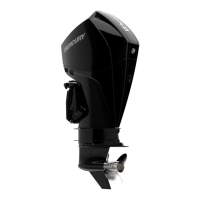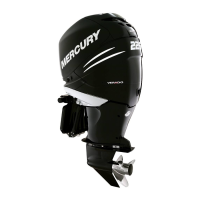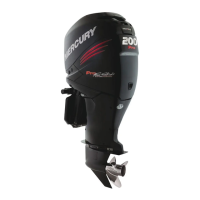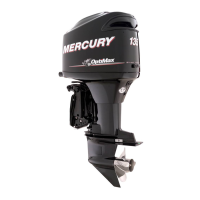•
Examine the Freeze Frame buffers, which do not relate to active or inactive faults. Be careful about faults that
happened a long time ago and only happened once or twice.
•
Use the freeze frame information to determine the state of the engine when the fault occurred. Refer to Section 3D ‑
CDS G3—PCM 112 Freeze Frame Data.
• If there are multiple faults:
• Look for shared circuits and relationships between the components. If failed sensors share the same power or
ground connection, examine the harness for opens or shorts.
• O2 sensor faults may be the result of other faults upstream. For instance, a failed fuel injector can lead to an O2
sensor out‑of‑range fault. Fix the other faults first, test the boat, and see if those repairs addressed the O2
sensor faults.
• Continue diagnosis on each fault until you can clear them, and they don’t come back after a test run on the water.
10.
If there are no faults and there are no symptoms, then you are finished. Do not get caught chasing a problem that
does not exist. Return the boat to service.
Fault Codes
This engine uses universal fault codes. Refer to Section 4A ‑ Fault Codes for a complete list of those used on the PCM 112.
These codes will help ensure uniformity in fault reporting in this and future control modules. It will also help ensure that boat
operators will receive consistent information and instructions, such as Service Engine Soon, Reduce Engine Speed, and
others in response to specific faults.
Active fault list example (actual screen appearance may vary)
a - Fault code (the affected component)
b - Fault type code (how it was affected)
c - Code description
d - Fault type code description
In the last line of this example, fault code 208, Fuel injector circuit 8, had a fault type code 16, meaning that the PCM 112 is
unable to output a signal to the device. This could indicate a faulty fuel injector. In this case, the same fault is affecting multiple
injectors, which likely indicates a more widespread fault, such as an unplugged harness, issues with a power supply, or some
other systemic issue.
A complete list of fault types and codes is in Section 4A.
Addressing Faults
A fault indicates that the PCM has detected that the circuit in question has recorded a sensor value outside of its acceptable
window, or that a sensor value has gone outside its normal range. Faults rarely indicate a defective PCM. Assume that the
PCM is working correctly until complete and thorough troubleshooting procedures prove otherwise.
1. Connect the CDS G3 diagnostic tool and check for faults.
a.
A circuit with an open or short would give a fault that is an Input High or Input Low. This means that the sensor itself
has failed with an open or short circuit, or one of the leads between the sensor and the PCM is open or shorted. An
Input High fault means that the PCM is seeing a 5‑volt signal. An Input Low fault means that the PCM is seeing no
voltage.
b.
A sensor showing a reading outside of its normal range, but not shorted or open, has a Range High or Range Low
fault. This means the circuit is operating correctly, but the engine is outside of its operating range, such as engine
coolant overheating.
Troubleshooting with the Computer Diagnostic System (CDS G3)
Page 3B-14 © 2018 Mercury Marine 90-8M0146617 eng JULY 2018

